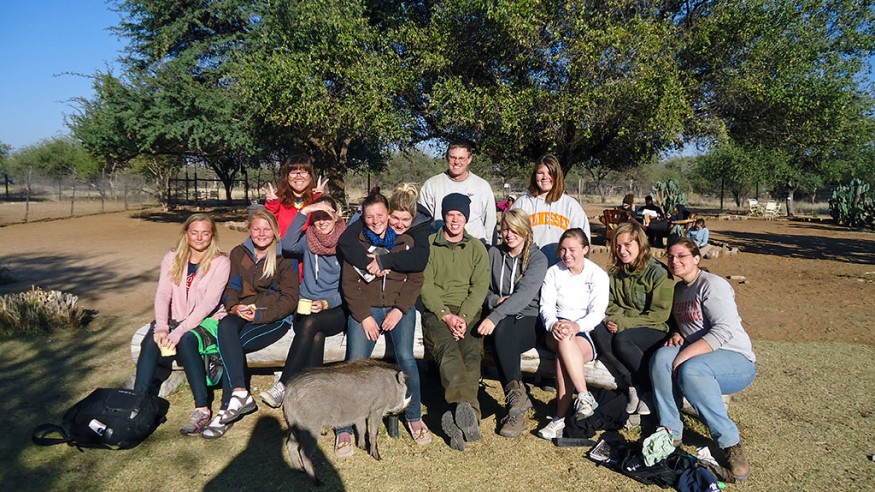
Finding Sanctuary in Africa
Julie Stark ’15 and friend at the Harnas Wildlife Foundation animal sanctuary. (Photo courtesy of Julie Stark ’15)
Ohio Wesleyan junior Julie Stark chose to transfer to OWU because of the University’s strong biology department, but also because she had read stories about the Theory-to-Practice Grant opportunity. Stark also was inspired after reading The Soul of a Lion, by Barbara Bennett, a chronicle of the Harnas Wildlife Foundation in Namibia, South Africa. Once the zoology major was on campus, she began writing her research proposal which, if granted by OWU, would enable Stark to spend several weeks volunteering at the Harnas animal sanctuary, owned by Marieta van der Merwe. An excited Julie Stark flew into Johannesburg in early June, arriving at the sanctuary several hours later, and looking forward to learning about how to rehabilitate and care for ill and injured animals—the overarching mission of the Harness Wildlife Foundation.
“I’ve always been interested in conservation and animal rehabilitation,” says Stark whose days at Harnas began at 6:30 a.m. with a two-mile trek from the cabin area housing the 30-plus volunteers from more than seven countries, to the farm and sanctuary for breakfast. Then the group met on the lawn with managers of the farm to divvy up the day’s chores. Feeding the animals—10 lions, 20 cheetahs, one leopard, 50 mongeese, 50 meerkats, and an assortment of lynx, caracals, wild does, and warthogs—was a top priority, as were cleaning enclosures and tending to broken equipment. But sleeping with orphaned baby baboons? How was that part of the “job description?
Like most babies, the baboons needed the comfort of a parent, and the volunteers took turns being moms and dads for a night.
“I became aware of these animals’ likes and dislikes in an instinctual way,” says Stark, who describes their child-like curiosity. “If they bite, you can’t react. Instead you must try to convince them to do something else. If they pulled my hair, I’d pretend to be interested in something in the room to distract them.” Stark’s experiences with the cheetahs showed her that since they classify others as either predators or prey, she had to look them in the eyes and not wear sunglasses.
Harnas volunteers. (Photo courtesy of Julie Stark ’15)
“We learned these things without reading books or being in classrooms,” says Stark, adding that the sanctuary staff offered a few basic instructions. “And then we were on our own to work with animals needing various levels of care.” Those in Level 1 were most needy, suffering from abuse or serious illnesses. Level 2 animals couldn’t be free but could live on their own and hunt, and those classified as Level 3 were free to roam more than 700 acres of the fenced farm area and live as if in the wild. Radio collars help the sanctuary staff keep track of these animals. Another sanctuary nearby houses the much larger elephants and rhinoceros. Stark’s advice? “If an elephant charges, everyone in your group should go off in different directions and find a tree. And if a wild dog attacks, roll up in a ball to protect your stomach and ankles.” It was, says Stark, during moments like those that she realized fully where she was and the importance of getting to know these animals. All animals, she explains, have natural instincts, and it takes understanding and knowing that they will usually warn you before they act.
“Another reason I was drawn to Harnas is that they insist that all volunteers know the names of each animal, and not just the breed,” she says. “I loved that value and practice.”
As for the future, Stark knows she’ll continue working with animals, wherever that work exists for their benefit and well-being.
